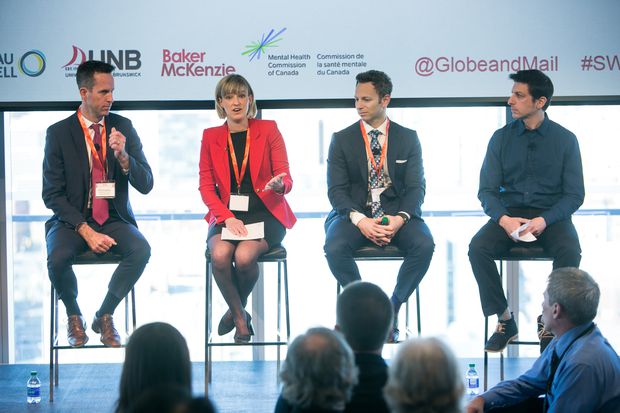Panel discussions: focus on the table skirt not the woman’s skirt

Over the years, I’ve been on, and attended, a lot of panel discussions and conferences. When I am on a panel discussion, I am generally on stage sitting in a deep chair that isn’t quite comfortable. In recent years, there’s been more awareness of the need for inclusivity in panels, and moving away from the manel to ensure women’s voices are heard. Given my field, these panels tend to be at a conference of professionals. It’s a formal atmosphere that is intended to make everyone feel like we take these things seriously. I’ve noticed a trend lately of doing away with that look and feel to try to make people feel more approachable and less … stuffy. I’m not convinced it works.
This came to mind recently when I saw an image of a group of people seated in front of a camera; all the women were nervously tugging on the hems of their skirts, knees tightly together, while the men were manspreading. No one looked comfortable, or professional.
The ergonomics of sitting are a huge topic lately, but what we’re usually discussing is people sitting and working. On conference speaker panels, it’s such a one-off for most people that the organizers don’t think to ask about the panelist’s comfort unless they have a specific need, like accommodation for restricted mobility. In a real sense you, as one of the speakers, expect the conference people to take care of you. The organizers may have a more pressing motivation, for instance, to get paying butts in chairs, so they want the approachability and cool factor of modern furniture that is out of the question when you think about an older style conference table and table cloth.
So what do the hosts do? They set up a bank of deep lounge chairs, usually black, and sometimes they put a side table for your water glass. If you are a short person you have to perch on the edge or you look ridiculous because your feet don’t touch the floor. As a plump person, you look slouchy because your torso is compacted, and as a person in a skirt you shift a lot as you try to keep your skirt from riding up. Who looks good? Tall non-skirt-wearing people. Everyone else looks uncomfortable, which the audience translates as nervous or defensive. So everyone else’s credibility is damaged – because of a chair.
When the hosts can’t be bothered to put up a side table, you’re stuck holding a bottle or glass of water, which you toy with, or have to lean over and put on the floor, and hope you don’t knock it over. Let’s face it, being on a panel and public speaking is nerve-wracking as it is, you don’t need to be more nervous.
You might think the bar height chair or the director’s chair is a better solution. But think of a skirted person crossing their legs, you can see up the outside of the thigh, or worse. Or if they do the classic knees together they look prissy. Invariably the skirted person spends their time tugging and adjusting. You may think, why don’t they wear pants? Because society encourages all women to wear skirts when trying to look professional and they didn’t know the conference organizers were going to sabotage them.
Men don’t look any more comfortable unless they’re over six feet tall. Those director chairs or stools mean your feet dangle. It’s even worse for women because their shoes can fall off and there’s nowhere to rest their feet. High heels, which society encourages women to wear, can’t rest on the rail of the chair or foot rest of the high-top table in front of them.
So I say let’s go Victorian: give our tables modesty curtains so that everyone on the panel is comfortable and keeps whatever dignity they came in with. I think it’s okay to remind the audience that they are here to take things seriously and listen to the speaker, not to look at their skirt.
Photo Credit:
Glenn Lowson, Cannabis Concerns at Work, Globe and Mail, March 27, 2018.